I don't think you're crazy. I think the drawing is showing that you need to remove the plastic pieces protecting the threads on the mounting posts, before you install the back plate. Have you received the box yet? A quick look inside will verify if the threads are covered or exposed.
You are using an out of date browser. It may not display this or other websites correctly.
You should upgrade or use an alternative browser.
You should upgrade or use an alternative browser.
Electric burners - Any builders out there?
- Thread starter CidahMastah
- Start date

Help Support Homebrew Talk - Beer, Wine, Mead, & Cider Brewing Discussion Forum:
This site may earn a commission from merchant affiliate
links, including eBay, Amazon, and others.
bruin_ale
Well-Known Member
No, it says to toss the standoff holders into the garbage. Your panel should have had these plastic caps over the four backplate standoffs and the grounding posts. They're trivial, toss 'em and install the backplate.
Good call, it's been awhile since I used mine - but now that you mention it, I do recall tossing the plastic standoff covers.
CidahMastah
Well-Known Member
- Joined
- Nov 12, 2010
- Messages
- 4,201
- Reaction score
- 46
I don't think you're crazy. I think the drawing is showing that you need to remove the plastic pieces protecting the threads on the mounting posts, before you install the back plate. Have you received the box yet? A quick look inside will verify if the threads are covered or exposed.
Ha! one of those things that I probably would have figured out in about... 5 seconds after looking at the box....:cross:
Thanks guys!
CidahMastah
Well-Known Member
- Joined
- Nov 12, 2010
- Messages
- 4,201
- Reaction score
- 46
Hey all I just got a couple major pieces to the puzzle in for my ebuild 2.0. Based on the cost of certain parts my design totally changed. Have a quick look and let me know what you think. This is my intended layout.
Notes:
I only have 2 PIDs. With this design I can throw a 3rd in the center down the road without it looking funny. So imagine the MT PID absent for this build (cardboard in the picture). Also, I can add another alarm and pump in the center if I ever bump up to three pumps.
Currently I plan on having the green light represent power to the terminal block on (one for each separate 30amp feed) and orange will be element fired.
Card board represents BK MT and HLT PIDs, respectively.
Oh yeah, the upside down lights are supposed to be on off switches (don't have the rest of them in yet)
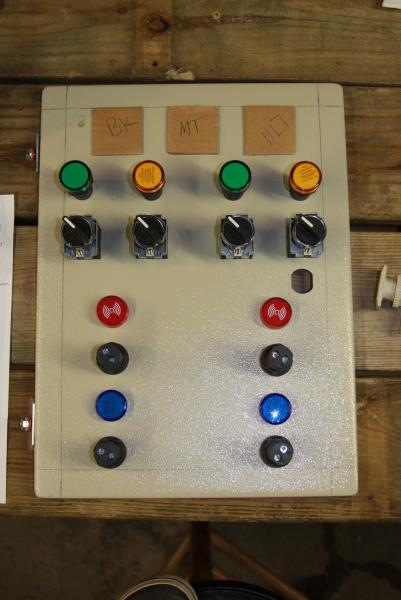
Notes:
I only have 2 PIDs. With this design I can throw a 3rd in the center down the road without it looking funny. So imagine the MT PID absent for this build (cardboard in the picture). Also, I can add another alarm and pump in the center if I ever bump up to three pumps.
Currently I plan on having the green light represent power to the terminal block on (one for each separate 30amp feed) and orange will be element fired.
Card board represents BK MT and HLT PIDs, respectively.
Oh yeah, the upside down lights are supposed to be on off switches (don't have the rest of them in yet)

CidahMastah
Well-Known Member
- Joined
- Nov 12, 2010
- Messages
- 4,201
- Reaction score
- 46
Hey guys need some help. Do the contactors need a a ground? I,e, i am trying to figure out how I am going to power my switches that will activate (turn on) the contactors to send two hots to my terminal block. Can I simply use a 2 prong cord with a hot and a neutral? I was thinking of running a 120 line in to supply power to activate two contactors.
Plan being:
1. run a 2 prong cord with the hot into the contactor coil (switch to control opened or closed)
2. The neutral from the same cord goes into the opposite side of the coil on the contactor.
This way I can use a regular low amperage switch to power the two contactors that will turn on/off the power to each of my two terminal blocks. 1 120 line running into the control panel. Spliced so hots will go to the hot side of each of the two terminal blocks. Splice neutrals and return on the 2 prong plug, from each of the two contactors.
Just a reminder, my set up is using two independent terminal blocks for two independent supplies of 30amps to each side of the panel. I want to control the power feed to each terminal block.
Plan being:
1. run a 2 prong cord with the hot into the contactor coil (switch to control opened or closed)
2. The neutral from the same cord goes into the opposite side of the coil on the contactor.
This way I can use a regular low amperage switch to power the two contactors that will turn on/off the power to each of my two terminal blocks. 1 120 line running into the control panel. Spliced so hots will go to the hot side of each of the two terminal blocks. Splice neutrals and return on the 2 prong plug, from each of the two contactors.
Just a reminder, my set up is using two independent terminal blocks for two independent supplies of 30amps to each side of the panel. I want to control the power feed to each terminal block.
bruin_ale
Well-Known Member
Having a hard time following what your plan is, but it sounds weird - running a separate "two-prong" cord to activate the contactors? How is that any different than just taking 1 leg of any of your terminal blocks? They're both 110V right? Branch off one of those inputs, fuse it and run it through your low amp switch and to the contactor coil.
CidahMastah
Well-Known Member
- Joined
- Nov 12, 2010
- Messages
- 4,201
- Reaction score
- 46
Having a hard time following what your plan is, but it sounds weird - running a separate "two-prong" cord to activate the contactors? How is that any different than just taking 1 leg of any of your terminal blocks? They're both 110V right? Branch off one of those inputs, fuse it and run it through your low amp switch and to the contactor coil.
The problem is this switch is supposed to open/close the power to the terminal block. i.e. there wouldn't be any power coming to the terminal block, thus when the switch is activated it would not have any power to send to the contactor to close it.
I can understand your confusion. I would like to use two contactors to control the hot side input (for each phase) to each of my two terminal blocks. The plan being that I want to have a switch that activates the power to the terminal block for each side of the panel. To turn an element on you would need to turn the power switch, and then turn the element switch (Green light and then yellow light).
The issue I am running into is... if there is no power to the terminal block, I can't use a hot from the terminal block to power the contactor (controlled by a switch) to a closed state.
To mitigate this problem I had thought I could run a 120v line in to a switch to solely provide power to activate (close) the contactors that ultimately supply the two hot feeds to the terminal block. That line's sole purpose would be to supply 120 (through a switch) to the contactor for each side of my panel.
Hopefully the image below helps. There would be a 120v light that would be wired on the bottom side of switch (between the switch and the contactor). So when the switch is closed, the light goes on and the terminal block is energized giving power to the panel so PIDs and anything else are now on, or capable of being turned on (element, etc.).
neutral from the 120v light and the contractor would be spliced and joined back into the 120cord returning to teh wall socket.
Does that make sense?
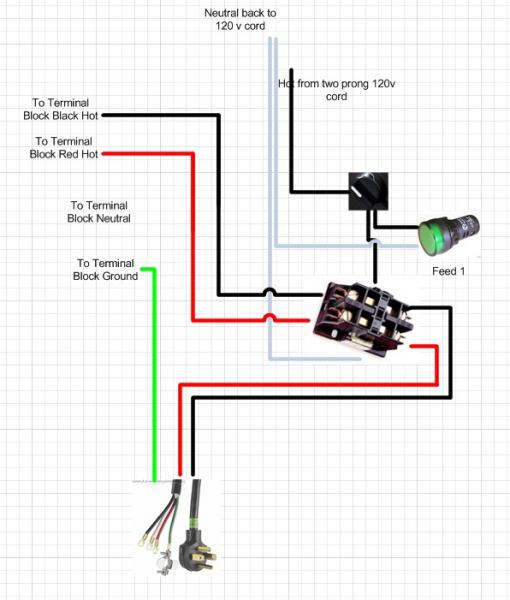
AlteredEgo
Member
CidahMastah, I've been reading your posts on this thread, would you mind if I took out an insurance policy on you?
CidahMastah
Well-Known Member
- Joined
- Nov 12, 2010
- Messages
- 4,201
- Reaction score
- 46
CidahMastah, I've been reading your posts on this thread, would you mind if I took out an insurance policy on you?
Appreciate your contribution and thanks for attempting to troll.
Ironic you saying that though. My system after it was built passed a certified electrician's inspection and has been in safe use for almost a full year. Where is your build?
CidahMastah
Well-Known Member
- Joined
- Nov 12, 2010
- Messages
- 4,201
- Reaction score
- 46
AlteredEgo
Member
I'm relieved to hear this. I'm pleased that you have a sense of humor. My all-electric build is working fine, thank you. An electrician friend certified my set-up before I plugged it in.My system after it was built passed a certified electrician's inspection and has been in safe use for almost a full year. Where is your build?
CidahMastah
Well-Known Member
- Joined
- Nov 12, 2010
- Messages
- 4,201
- Reaction score
- 46
I'm relieved to hear this. I'm pleased that you have a sense of humor. My all-electric build is working fine, thank you. An electrician friend certified my set-up before I plugged it in.
Not sure why you felt you had to take a jab at me. But I really don't care because I would rather ask a bunch of "dumb" questions to fully understand what I am doing before I pretend I understand and hurt myself or others.
To me it is pretty remarkable that I have learned as much as I have and was able to complete the first, and soon to be second major build for this control panel. Coming from a guy who about a year ago was nervous changing wall socket.
If you haven't already purchased your contactors then you could buy 240 volt coil units and just run power from the line in side of the contactor through your switch and activate the coil that way. Or you could bring in a neutral wire with your 240 volt main wiring and use 120 volts to activate the contactor if you already have 120 volt coil units.
It's always good to limit the number of power lines that are feeding into the enclosure because if there are more than a couple there is a chance that you will miss turning one of them off when you go to work inside.
It's always good to limit the number of power lines that are feeding into the enclosure because if there are more than a couple there is a chance that you will miss turning one of them off when you go to work inside.
CidahMastah
Well-Known Member
- Joined
- Nov 12, 2010
- Messages
- 4,201
- Reaction score
- 46
If you haven't already purchased your contactors then you could buy 240 volt coil units and just run power from the line in side of the contactor through your switch and activate the coil that way. Or you could bring in a neutral wire with your 240 volt main wiring and use 120 volts to activate the contactor if you already have 120 volt coil units.
It's always good to limit the number of power lines that are feeding into the enclosure because if there are more than a couple there is a chance that you will miss turning one of them off when you go to work inside.
You touched on my main concern - possible design flaw. While I believe that the way I presented the wiring will work, I dislike having 3 feeds... hmm..
I already have the contractors. Perhaps I could leave one hot always on the panel? and only use one side of the contactor for the second phase.
CidahMastah
Well-Known Member
- Joined
- Nov 12, 2010
- Messages
- 4,201
- Reaction score
- 46
Or you could bring in a neutral wire with your 240 volt main wiring and use 120 volts to activate the contactor if you already have 120 volt coil units.
I think I read this wrong. So are you saying that I could take the neutral from the main feed to power the contactor at the main? Where would I route the neutral side of the the contactor?
The unit I have is a 2 pole x 120v contactor (This same P/N) I was trying to use one contactor for each side of my panel
Ok so I was trying to read back through this thread and catch up on what you finally decided to do. Can you give me a quick refresher on how you decided to feed your garage with power and what you were feeding your panel with. A PM is fine if you want. And just for your knowledge your brother in law is one of my brothers. IBEW 191
CidahMastah
Well-Known Member
- Joined
- Nov 12, 2010
- Messages
- 4,201
- Reaction score
- 46
Ok so I was trying to read back through this thread and catch up on what you finally decided to do. Can you give me a quick refresher on how you decided to feed your garage with power and what you were feeding your panel with. A PM is fine if you want. And just for your knowledge your brother in law is one of my brothers. IBEW 191
Very cool and thanks - PM on the way. He is a good egg and was shocked* when I showed him "what I had been up to".
*not literally shocked haha, pun intended
CidahMastah
Well-Known Member
- Joined
- Nov 12, 2010
- Messages
- 4,201
- Reaction score
- 46
OK as an update, I wanted to post the following wiring for my predicament as listed above. In order to control the main power feed at the contactors for each side this will be the following wiring format. I will replicate this for each side of the build.
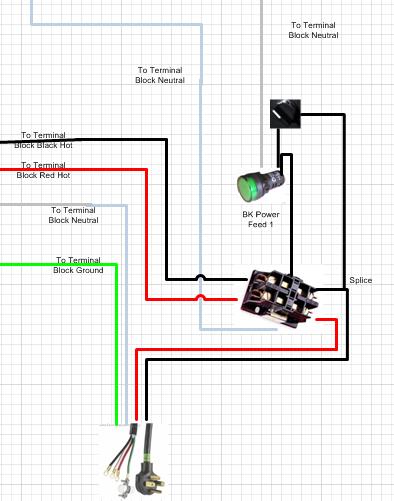

CidahMastah
Well-Known Member
- Joined
- Nov 12, 2010
- Messages
- 4,201
- Reaction score
- 46
Did a mini mock up of the control panel on a 1/4 inch piece of wood cut to scale of my box. I think this will be what I am going with!
I also mocked up some cutout paper to plan where I am putting my power/probe receptacles
Really glad I did this so now I have a template and am sure the spacing is correct for usability.
(the lady hiding behind the panel)
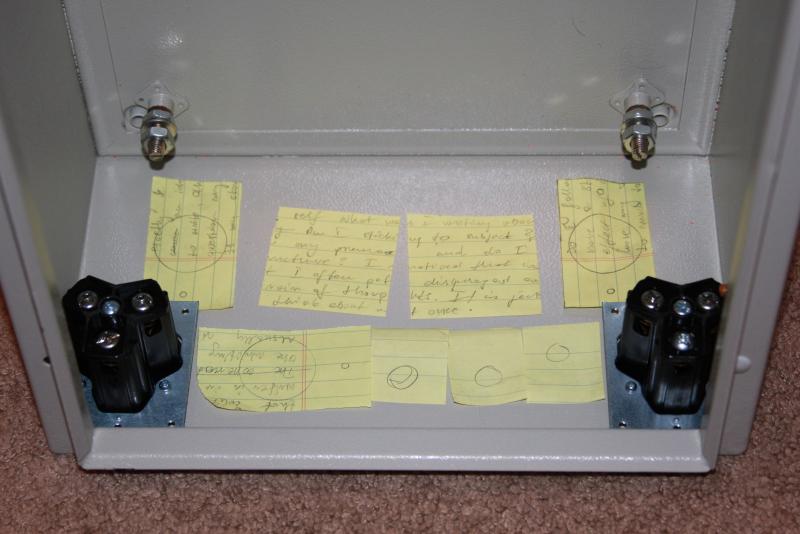

I also mocked up some cutout paper to plan where I am putting my power/probe receptacles
Really glad I did this so now I have a template and am sure the spacing is correct for usability.
(the lady hiding behind the panel)


Did a mini mock up of the control panel on a 1/4 inch piece of wood cut to scale of my box. I think this will be what I am going with!
I also mocked up some cutout paper to plan where I am putting my power/probe receptacles
Really glad I did this so now I have a template and am sure the spacing is correct for usability.
(the lady hiding behind the panel)
Cidah
Looks good man I will like to see how the rest of the build progresses. What all are you placing at the bottom? sure looks like alot of things for that tight spot, think it will be hard to wire!
CidahMastah
Well-Known Member
- Joined
- Nov 12, 2010
- Messages
- 4,201
- Reaction score
- 46
Cidah
Looks good man I will like to see how the rest of the build progresses. What all are you placing at the bottom? sure looks like alot of things for that tight spot, think it will be hard to wire!
Yeah it is a bit tight!
I need to have space for two of those nema flange receptacles (one for eace of my two sides on the panel). Then I have space for 3 probes (3xlr panel mount). The 30 amp 3wire outlets you see in the pic will be there too (HLT and BK). Right now I have put in 3 120v 20amp plugs too. Those would be for at least 2 pumps. I have been toying with the idea of the third and last plug to be power to an HLT stirring motor, but still have not decided.
So lots of stuff! If I have to lose a plug it will be 1 of the 120v. However I am not cutting a thing until I get all the actual hardware in my hand to be sure it doesn't obstruct anything in my layout. Patience patience!
Of course I had to go for a 60amp panel that was redundant (essentially cramming the guts of 2 panels into one). Worse yet, I went for a 16x12x8 box vs. the 16x16x8. But I know it will all fit!
CidahMastah
Well-Known Member
- Joined
- Nov 12, 2010
- Messages
- 4,201
- Reaction score
- 46
A couple more pictures to add. Last weekend I received my ebay heat sink so I cut out the heat sink section on the box and perfect fit! Then I tapped it and the main board where the terminal blocks and contactors will be located.
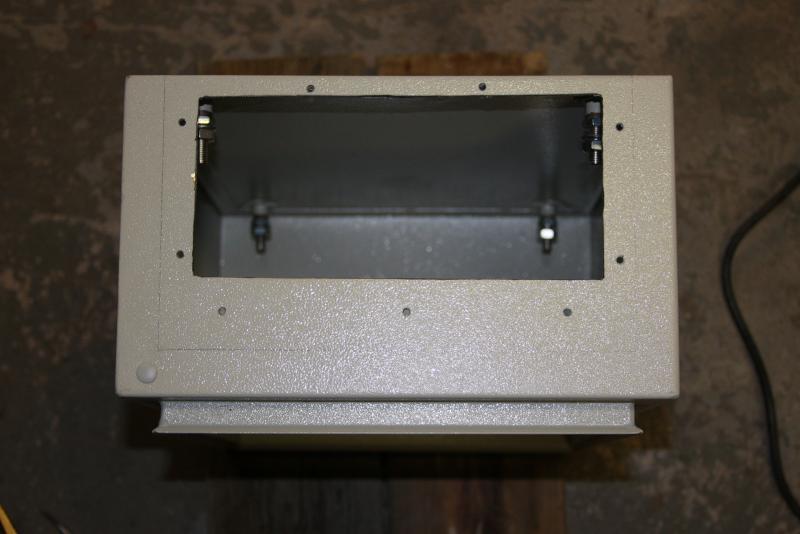

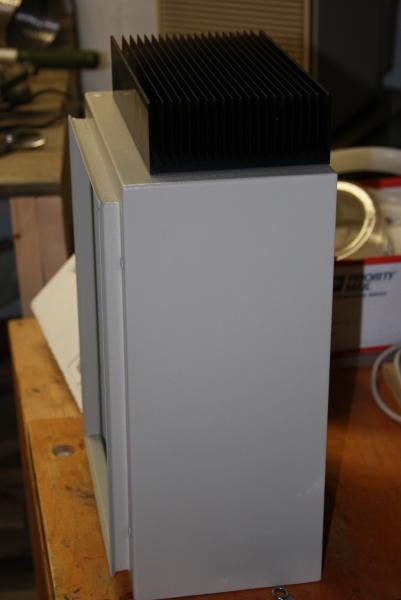





CidahMastah
Well-Known Member
- Joined
- Nov 12, 2010
- Messages
- 4,201
- Reaction score
- 46
I am considering adding a 3rd PID and was looking at the Auberins SYL-2352P so I could ad ramp functionality. Does anybody have any personal experience with this PID?
I am debating if a ramp-able PID is something I will really need/use in the future. If it is a worth while investment.
I am debating if a ramp-able PID is something I will really need/use in the future. If it is a worth while investment.
Well originally this all started as just looking for a way to cheaply boil my wort via electric. It seems like, with all the nifty gadgets, it my grow into a much more automated set up. If you are buying the PID you might as well think about the longterm set up, and using it for all aspects of the process. The idea of monitoring the mash is especially appealing.
This is how it starts

CidahMastah
Well-Known Member
- Joined
- Nov 12, 2010
- Messages
- 4,201
- Reaction score
- 46
CidahMastah
Well-Known Member
- Joined
- Nov 12, 2010
- Messages
- 4,201
- Reaction score
- 46
Mad some progress. I am ready for paint!
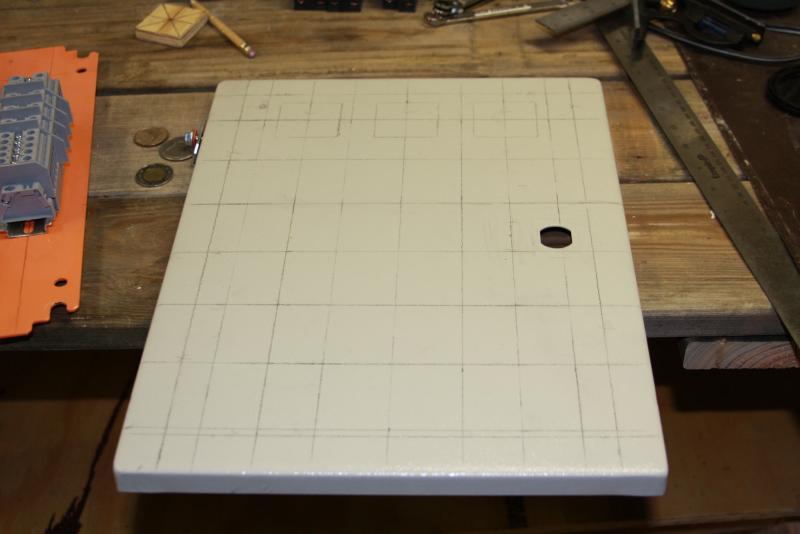


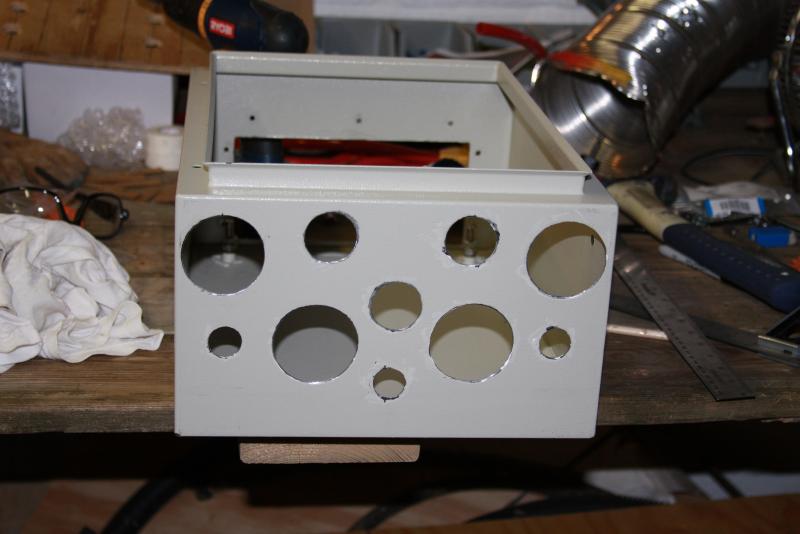




CidahMastah
Well-Known Member
- Joined
- Nov 12, 2010
- Messages
- 4,201
- Reaction score
- 46
and some more. Starting to look like something. Did some deburring as well
I also drilled and taped my heat sink, so that is all set for action to. Can't wait to get the the paint, then wiring this week
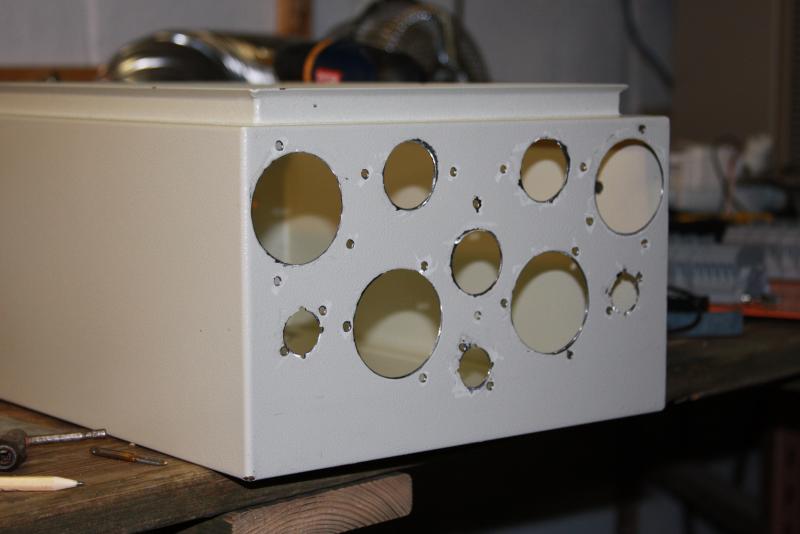

I also drilled and taped my heat sink, so that is all set for action to. Can't wait to get the the paint, then wiring this week


looking good Cidah I think you have a lot going on in that small area!!
CidahMastah
Well-Known Member
- Joined
- Nov 12, 2010
- Messages
- 4,201
- Reaction score
- 46
looking good Cidah I think you have a lot going on in that small area!!
I measured all the stuff out, then checked clearances with measure, then with actual parts in place and looks like I will have plenty of space. The space will require me to keep things neatly wired, but that is part of the beauty of the electrical rigs. Nice neat and secured wiring!
Can't wait to settle up the painting and then to get the hardware in place for wiring. Still waiting on my switches from china though.... suckers. now they are past due and it would really suck to have them refund me with no switches in hand. Hopefully they come in this week right after I get the painting done.
the cool part about the receptacles is that with the current set up I will have the ability to have 3 120 outlets. 2 are spoken for with pumps with one unclaimed. This will either be for a third pump down the road, a ventilation hood fan or a mechanical stirrer for the HLT when I complete my eherms.
I measured all the stuff out, then checked clearances with measure, then with actual parts in place and looks like I will have plenty of space. The space will require me to keep things neatly wired, but that is part of the beauty of the electrical rigs. Nice neat and secured wiring!If I went with the larger box I think it would have been too much space. I like the current layout I have because it isn't over crowded, but uses up the space on the panel.
Can't wait to settle up the painting and then to get the hardware in place for wiring. Still waiting on my switches from china though.... suckers. now they are past due and it would really suck to have them refund me with no switches in hand. Hopefully they come in this week right after I get the painting done.
the cool part about the receptacles is that with the current set up I will have the ability to have 3 120 outlets. 2 are spoken for with pumps with one unclaimed. This will either be for a third pump down the road, a ventilation hood fan or a mechanical stirrer for the HLT when I complete my eherms.
I will have to come down for a brew day when your all up and running!!! Will be interesting to see and I can always bring down 4.5 lbs of grain to add to the batch!! LOL
CidahMastah
Well-Known Member
- Joined
- Nov 12, 2010
- Messages
- 4,201
- Reaction score
- 46
I will have to come down for a brew day when your all up and running!!! Will be interesting to see and I can always bring down 4.5 lbs of grain to add to the batch!! LOL
ha - you said it! :cross: I simply can't wait to get this off and running. I am taking deep breathes to keep my patience on the project so:
(a) I don't drive my wife crazy hanging out in in the wood shop (cellar)
(b) I don't rush a step and compromise all the hard work so far
CidahMastah
Well-Known Member
- Joined
- Nov 12, 2010
- Messages
- 4,201
- Reaction score
- 46
Polished up my wire diagram last night and now I am feeling pretty good.
1. Panel painted.
2. Some receptacles installed.
3. Wiring diagram finalized
All that is left is for me to paint / attach the swing arm hardware to the back of the control box. Once I do that I will be able to wire this bad boy up!
.... of course I am still waiting on my last PID as well as a bunch of switches from china... Hope I get them before the week closes up.
Will post some pics of the progress when i can!
1. Panel painted.
2. Some receptacles installed.
3. Wiring diagram finalized
All that is left is for me to paint / attach the swing arm hardware to the back of the control box. Once I do that I will be able to wire this bad boy up!
.... of course I am still waiting on my last PID as well as a bunch of switches from china... Hope I get them before the week closes up.
Will post some pics of the progress when i can!
CidahMastah
Well-Known Member
- Joined
- Nov 12, 2010
- Messages
- 4,201
- Reaction score
- 46
OK so some new picks!
First we have some paint shots and then some partially filled in slots for the panel. Now it is really taking off. If I have my way I will be able to wrap up the wiring this weekend!!
Other pictures include my swing arm. I pulled down a satelite dish arm from outside my house and cleaned it up and painted the mount. You can see the angle of display will be adjustable. Since I needed to mount that before wiring (once back plate is in hard to access) I added that now.
Before I start wiring I need to solder my probes and put in the last of the receptacles.
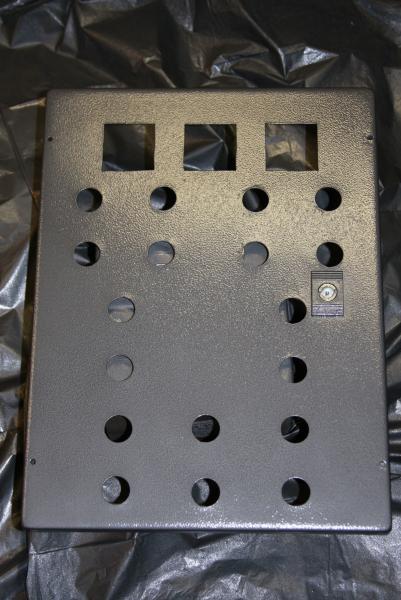
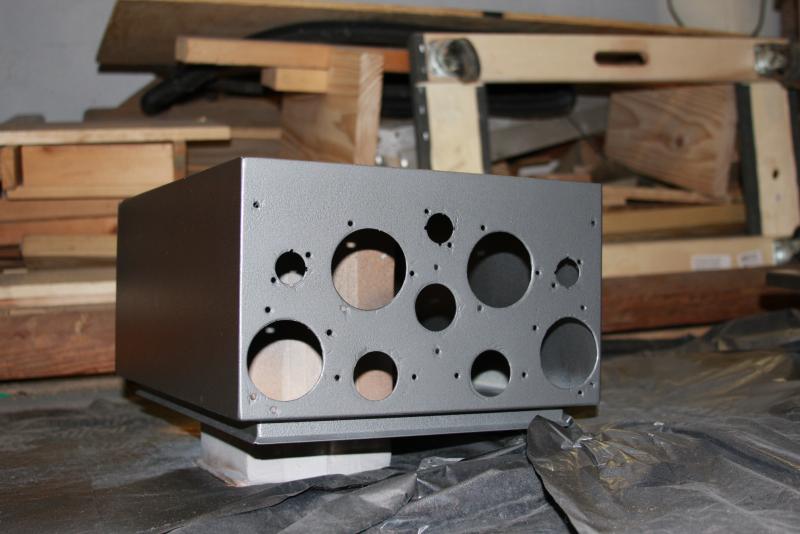
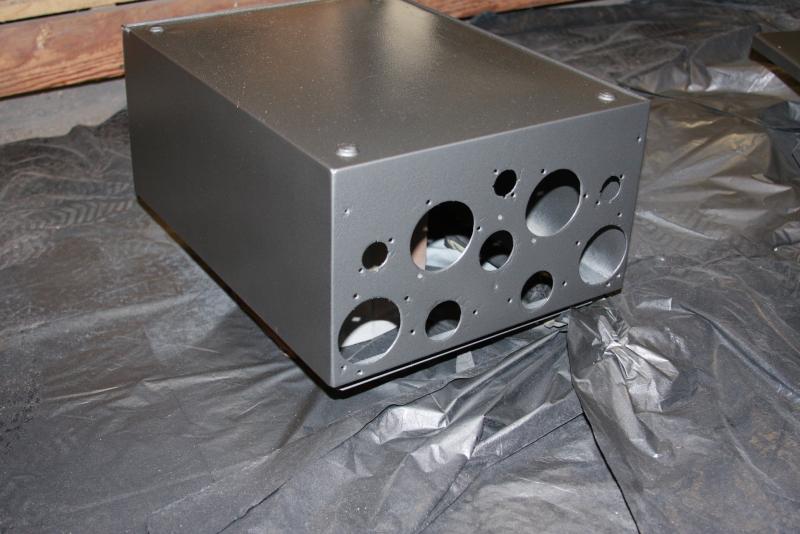

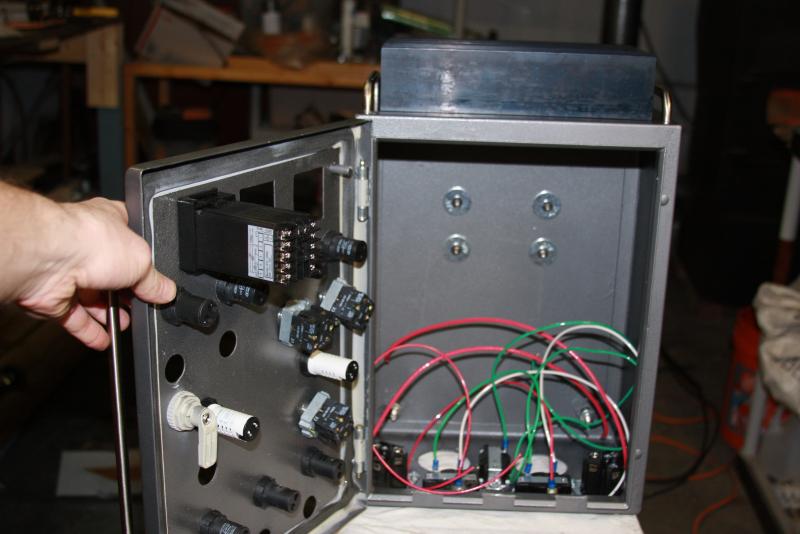
First we have some paint shots and then some partially filled in slots for the panel. Now it is really taking off. If I have my way I will be able to wrap up the wiring this weekend!!
Other pictures include my swing arm. I pulled down a satelite dish arm from outside my house and cleaned it up and painted the mount. You can see the angle of display will be adjustable. Since I needed to mount that before wiring (once back plate is in hard to access) I added that now.
Before I start wiring I need to solder my probes and put in the last of the receptacles.





CidahMastah
Well-Known Member
- Joined
- Nov 12, 2010
- Messages
- 4,201
- Reaction score
- 46
The control arm mount in place and a sneak peak at the panel with some of the lights and switches filled in.




jbsengineer
Well-Known Member
Seeing how close you are to finishing helps motivate me!
What did you paint the panel with? Came out great!!
What did you paint the panel with? Came out great!!
CidahMastah
Well-Known Member
- Joined
- Nov 12, 2010
- Messages
- 4,201
- Reaction score
- 46
Seeing how close you are to finishing helps motivate me!
What did you paint the panel with? Came out great!!
I am glad I am motivating you!
First let me say I hate painting, it usually is the part where I screw up hours of hard work. My wife looked at the paint enclosure perplexed, paused and said, "It looks professional". Haha - not sure I would go that far but I really thought it turned out pretty well all things considered.
I went with rustoleum's grey hammered finish (aerosol). If they would have had a burnt orange or red I might have went that route, but I actually like the grey too (didn't have the red in the HD where I picked it up). It says you can apply direct with no primer but I lightly sanded and primed anyhow. The black was too dark for me. I really wanted to go with the silver color, but I compromised for the grey based on opinions from my wife and buddy. We plan to paint the whole steel stand with this color as well as the control arm so it looks uniform.
CidahMastah
Well-Known Member
- Joined
- Nov 12, 2010
- Messages
- 4,201
- Reaction score
- 46
Inline Splice:
I have read that inline splicing/soldering of a wire is not allowed in household wiring according to code (on electrical forums so I am not sure of the code myself). Is there a "best" way to do this? I am going to be adding about 20 feet of 10-4 wire to 8 or so feet of 10-4 dryer cord. I would like to use the best low profile way so it looks good and is functional. After reading it wasn't to code I thought maybe there was a better way to do it.
I know this wouldn't be house wiring anyhow, it would be extension cord wiring. But this will have a lot of amperage to it so I wanted to go with the best way possible. Any of you wire benders out there have suggestions?
I have read that inline splicing/soldering of a wire is not allowed in household wiring according to code (on electrical forums so I am not sure of the code myself). Is there a "best" way to do this? I am going to be adding about 20 feet of 10-4 wire to 8 or so feet of 10-4 dryer cord. I would like to use the best low profile way so it looks good and is functional. After reading it wasn't to code I thought maybe there was a better way to do it.
I know this wouldn't be house wiring anyhow, it would be extension cord wiring. But this will have a lot of amperage to it so I wanted to go with the best way possible. Any of you wire benders out there have suggestions?
You can't use regular wire nuts and do an open splice in a wall or ceiling but it is perfectly fine to run both ends of wires into a junction box and splice with wire nuts in there. Another option is to buy a splicing kit from an electrical supplier. Tyco makes one that has 4 set screw style butt splices in a preformed plastic housing that you then cover with heat shrink. The cheapest way is to use individual mechanical splices (set screw or crimp style) and heat shrink each one separately and then heat shrink the whole group together.
The idea is to make an unbroken length of wire with no exposed splices that can work loose and start a fire. I have used all of these methods and they all work very well.
The idea is to make an unbroken length of wire with no exposed splices that can work loose and start a fire. I have used all of these methods and they all work very well.
CidahMastah
Well-Known Member
- Joined
- Nov 12, 2010
- Messages
- 4,201
- Reaction score
- 46
For this specific application will be an extension cord format (bulk wire at Home depot) with a rubber outdoor rated casing (so I prefer not to use a junction box). I am taking one of these and adding 20 feet of the home depot wire plus the leviton connector to a flange panel mount.
My concern is that the joining is sound even with some movement of the cord. i.e. I don't want the connection breaking or getting damaged if I pick up, move step on the cord, etc (within reason of course).
Was thinking of either butt splice crimps (but they are bulky) or shrink solder connections and then a shrink tub casing over all connections that.
yjfun - you missed the member drive. You could see the pictures of my progress!!
My concern is that the joining is sound even with some movement of the cord. i.e. I don't want the connection breaking or getting damaged if I pick up, move step on the cord, etc (within reason of course).
Was thinking of either butt splice crimps (but they are bulky) or shrink solder connections and then a shrink tub casing over all connections that.
yjfun - you missed the member drive. You could see the pictures of my progress!!
Last edited by a moderator:
Similar threads
- Replies
- 10
- Views
- 670
- Replies
- 4
- Views
- 708

